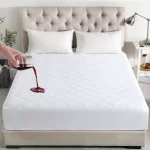Bed Bug Season is Approaching: How to Protect Your Bedding with Bed Bug Protectors from Cover and Protect

As the warmer months approach in Australia, so does the dreaded bed bug season. These tiny pests are more than just an inconvenience – they can cause sleepless nights, skin irritation, and a major headache for both households and accommodation providers.
With international travel booming again and seasonal changes creating ideal conditions for infestations, bed bugs are making an unwelcome comeback across hotels, motels, backpacker hostels, and even private homes. Prevention is far easier – and far less stressful – than trying to get rid of bed bugs once they’ve taken hold.
At Cover and Protect, we specialise in high-quality bedding protection designed to safeguard against bed bugs, dust mites, allergies, and everyday wear. One of the most effective ways to defend your mattress and pillows from infestation is with bed bug protectors. In this article, we’ll explore why bed bugs become such an issue at certain times of year, how they spread, and most importantly – the practical steps you can take to protect your bedding.
Understanding Bed Bug Season in Australia
While bed bugs can strike at any time, they tend to be more active and spread more quickly during the warmer months. Higher temperatures accelerate their breeding cycle, meaning infestations can get out of hand much faster.
In cities like Sydney, Melbourne, and Brisbane – where there is a high turnover of travellers – accommodation providers are especially vulnerable during peak travel season. Guests may unknowingly bring bed bugs in their luggage or clothing, introducing them into previously clean rooms.
Unlike other pests, bed bugs aren’t a sign of poor hygiene. They don’t feed on food scraps or rubbish – their only source of nutrition is blood. This makes beds, lounges, and upholstered furniture their perfect hiding and feeding spots. Once inside, they’re extremely difficult to eliminate without professional pest control.
How Bed Bugs Invade Your Bedding

Bed bugs are experts at hiding in small cracks and seams. They typically settle into:
- Mattress seams and labels
- Bed bases and headboards
- Pillow seams and zippers
- Skirting boards and behind wallpaper
- Luggage, clothing, and upholstered chairs
Once established, they emerge at night to feed, leaving small bites that can cause itching, redness, and in some cases, allergic reactions.
Their ability to spread quickly between rooms is one of the reasons accommodation facilities need to take prevention seriously. A single infested room can quickly turn into a building-wide problem if left unchecked.
Why Prevention is Key
Eradicating bed bugs after an infestation is costly, time-consuming, and disruptive. Professional pest control treatments often involve repeated visits and can require closing rooms or discarding mattresses altogether.
By contrast, preventative measures such as using bed bug protectors from the beginning can save thousands of dollars and countless complaints. For households, prevention also avoids the emotional stress of dealing with infestations that affect comfort and wellbeing.
How Bed Bug Protectors Work

Bed bug protectors, also known as mattress encasements or pillow protectors, act as a physical barrier between pests and your bedding. At Cover and Protect, our encasements are:
- Fully enclosed with a zippered design – preventing bed bugs from getting in or out.
- Made with durable fabrics – ensuring long-term use without tearing.
- Breathable and comfortable – designed to allow airflow so you still enjoy a restful night’s sleep.
- Tested for protection against dust mites and allergens as well – delivering multiple benefits in one product.
By sealing your mattress and pillows, you’re cutting off the most common hiding places for bed bugs. If an infestation is already present, encasements trap the bugs inside, where they eventually die due to lack of access to food.
Key Benefits of Using Bed Bug Protectors
- Peace of Mind
Whether you’re running a hotel or managing a family home, knowing your mattresses are protected allows you to rest easy. - Prolongs Mattress Life
Beyond pest protection, encasements guard against spills, sweat, and stains – extending the lifespan of your bedding investment. - Reduces Allergen Exposure
Many customers choose our protectors not only for bed bugs but also for asthma and allergy management, as they block dust mites and dead skin particles. - Cost-Effective
Replacing a mattress due to infestation or damage can cost hundreds or thousands of dollars. Protectors are an affordable insurance policy against such losses. - Easy Maintenance
Our protectors are machine washable, making them simple to clean as part of your regular housekeeping routine.
Practical Tips to Protect Your Bedding This Bed Bug Season
1. Use Quality Mattress and Pillow Encasements
Invest in encasements that are specifically designed for bed bug prevention. Not all protectors are created equal – fitted sheets and basic covers won’t stop pests. At Cover and Protect, our protectors are tested for both commercial and residential use.
2. Inspect Bedding Regularly
Train housekeeping staff or practice regular checks at home. Look for small reddish-brown spots, shed skins, or live insects around seams and edges of mattresses.
3. Be Wary of Second-Hand Furniture
Bringing in used beds, lounges, or wardrobes without inspection is one of the most common ways bed bugs enter homes. Always check carefully or avoid second-hand bedding altogether.
4. Launder Bedding Properly
Wash sheets, pillowcases, and protectors in hot water (60°C or above) where possible. Heat kills bed bugs and dust mites effectively.
5. Manage Guest Luggage
For accommodation providers, encouraging guests to keep luggage on racks rather than directly on beds can reduce the risk of pests spreading.
6. Act Quickly at the First Sign
If you notice signs of infestation, isolate the affected room or bedding immediately and consult a licensed pest controller. Using encasements at this stage will help contain the spread.
Why Choose Cover and Protect?
At Cover and Protect, we understand the unique challenges faced by both Australian households and the accommodation industry. That’s why our products are built for comfort, durability, and peace of mind.
Our Bed Bug Mattress Encasements and Bed Bug Pillow Protectors are trusted by:
- Hotels and motels
- Backpacker hostels
- Airbnb hosts
- Nursing homes
- Family households
We’re proudly Australian-owned and operated, supplying bedding protection solutions that balance affordability with commercial-grade quality. Whether you need a single protector for your child’s bed or bulk supply for your accommodation facility, we can help.
Customer Experiences
Many of our clients in the hospitality industry have seen firsthand the difference our protectors make. One Sydney hostel manager told us:
“Before using Cover and Protect encasements, we were spending thousands every year on pest control. Since fitting every mattress and pillow with your protectors, we haven’t had a single infestation. They’ve been a game-changer for us.”
Families also benefit greatly:
“Our son has asthma and we originally bought the protectors for dust mites. But knowing they also guard against bed bugs gives us extra reassurance, especially when relatives visit from overseas.”
Making Bed Bug Prevention Part of Your Bedding Routine
Bed bugs are a growing concern across Australia, and with the season fast approaching, now is the time to act. By integrating protective measures into your regular housekeeping and bedding management, you’ll significantly reduce the risk of infestation.
Think of bed bug protectors as part of your essential bedding setup – alongside sheets, doonas, and pillows. For hotels and accommodation providers, they should be considered non-negotiable, just like fresh linen and clean towels.
Final Thoughts
Bed bug season may be approaching, but with the right precautions, you don’t need to lose sleep over it. Investing in quality bed bug mattress and pillow protectors from Cover and Protect is one of the simplest and most effective steps you can take to safeguard your bedding.
Prevention not only saves time, stress, and money – it ensures a safe, comfortable, and hygienic sleep environment for your guests, family, or yourself.
This season, don’t wait until the first signs of infestation. Get ahead with Cover and Protect’s proven solutions and enjoy peace of mind knowing your bedding is fully protected.
If you’re looking for high-quality, Australian-tested bedding protection, consider Cover and Protect. Our range of mattress, pillow, and quilt protectors are waterproof, allergen-proof, and designed to keep your bed safe from unwanted guests – bed bugs, dust mites, and everything in between.
Sleep well, knowing you’re protected.
Contact Us Today
Do you have questions about our products? We’re here to help! Whether you need guidance on the best protector for your needs or have inquiries about our offerings, our friendly team is happy to assist.
📞 Call us: 02 931 66654 (Mon-Fri) | 0408 113 089 (7 Days)
📩 Email us: sales@coverandprotect.com.au
At Cover & Protect, we’re more than just a bedding protection supplier—we’re your trusted partner in creating a safer, healthier, and more comfortable sleep environment. Shop our range today and experience the best in bedding protection!




